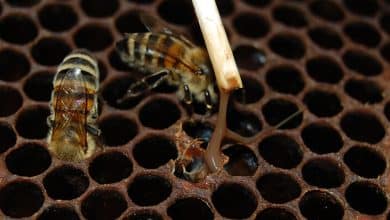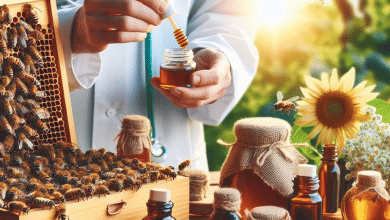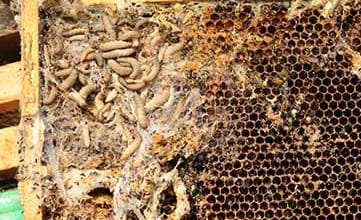Best Practices for Bee Sting Treatment in Children

Bee Sting Treatment can cause immediate pain and distress, especially in children whose immune systems and physical resilience differ significantly from those of adults. Understanding the composition of bee venom and the way it impacts a child’s body is crucial for prompt and effective Bee Sting Treatment.
Composition and Function of Bee Venom
Bee venom, also known as apitoxin, contains various compounds with specific effects:
- Melittin: The primary component, which causes pain and inflammation.
- Histamine: Triggers allergic reactions leading to itching and swelling.
- Phospholipase A2: Helps spread the venom by breaking down cell membranes.
- Hyaluronidase: Facilitates the dispersion of venom in tissues.
- Apamin: A neurotoxin affecting nerve cells and contributing to pain.
In children, these substances can cause more pronounced reactions due to their smaller body mass and developing immune systems.
Immediate Reactions
When a child is stung by a bee, the body reacts quickly. The initial symptoms typically include:
- Sharp pain or burning sensation at the sting site.
- Redness and swelling around the sting area.
- Itching and possible warmth of the affected region.
Potential Allergic Reactions in Children
Allergies to bee venom are relatively rare but can be severe. It’s essential to recognize whether your child has an allergy, as the reactions can range from mild to life-threatening. Boston Children’s can assist in identifying risk factors, conducting necessary tests, and providing suitable treatments.
A child with a bee sting allergy may exhibit:
- Hives or welts appearing on the skin away from the sting site.
- Wheezing or difficulty breathing.
- Swelling of the face, lips, or throat, which can be life-threatening.
- Nausea, vomiting, or diarrhea.
- Dizziness or fainting.
Factors Affecting Bee Sting Reactions in Children
- Multiple stings: More dangerous in children due to their lower tolerance for venom.
- Previous sensitization: Repeated stings may heighten immune response.
- Family history: Allergies can be hereditary; if a parent is allergic, careful monitoring of the child is advised.
It’s also worth noting that any break in the skin, including a bee sting, is prone to infection. Children should refrain from scratching the sting site to avoid introducing bacteria and causing further complications.
Bee stings in children necessitate careful management due to the potential for severe reactions and infections. By understanding the components and effects of bee venom, parents and caregivers can be better prepared to handle these situations. The expertise provided by Boston Children’s can be invaluable in identifying allergies, instructing on preventive measures, and managing any reactions that do occur.
Signs and Symptoms of Bee Stings in Pediatric Cases
Recognizing the signs and symptoms of bee stings in children is crucial for prompt and effective treatment. Bee stings can provoke a range of reactions, from mild discomfort to severe allergic responses. Here, we will outline the common symptoms children may exhibit after a bee sting and the key indicators that necessitate immediate medical attention.
Immediate Symptoms
When a child is stung by a bee, the initial symptoms usually present themselves quickly. Common immediate reactions include:
- Sharp pain or burning sensation: This occurs almost instantly at the sting site.
- Redness and swelling: The affected area may become red and swollen within a few minutes.
- Itching and localized warmth: These symptoms can follow the initial pain and swelling.
These reactions are caused by the bee venom, which has several active compounds that trigger pain and inflammation.
Mild to Moderate Symptoms
In many cases, children will experience mild to moderate symptoms, which might include:
- Localized swelling: The swelling may extend beyond the sting site, sometimes covering a larger area.
- Skin reactions: Redness, small blisters, or a raised welt around the sting site.
- Itching: Mild to severe itching may follow, which can be soothed using calamine lotion or hydrocortisone cream.
If swelling persists, a pediatrician might recommend an antihistamine to help reduce the symptoms.
Severe Allergic Reactions
It’s essential to be vigilant for signs of severe allergic reactions, also known as anaphylaxis. These symptoms can be life-threatening and require immediate medical intervention. Severe symptoms include:
- Widespread hives: Red, itchy welts appearing on areas of the skin not close to the sting site.
- Difficulty breathing: Wheezing or shortness of breath, which indicates airway constriction.
- Facial swelling: Swelling around the eyes, lips, tongue, or throat.
- Rapid pulse: An unusually fast heartbeat.
- Dizziness or fainting: Feeling lightheaded or losing consciousness.
- Nausea, vomiting, or diarrhea: Gastrointestinal symptoms occurring shortly after the sting.
Risk Factors for Severe Reactions
Certain children are at higher risk of severe reactions:
- Pre-existing allergies: Children who are allergic to other substances, such as pollen or dust, or have asthma.
- Previous sensitization: Those who have had severe reactions to bee stings in the past.
- Family history: A family history of bee sting allergies can increase the child’s risk.
If an allergic reaction is suspected, immediate steps should be taken to remove the stinger and seek emergency medical help.
Understanding the signs and symptoms of bee stings in pediatric cases is essential for ensuring prompt and effective care. By recognizing the immediate and severe symptoms, parents and caregivers can act quickly to alleviate discomfort and prevent complications. Always consult a pediatrician, especially if there is a history of allergies or previous severe reactions to bee stings. Preparedness and awareness can help manage bee sting incidents skillfully and safely.
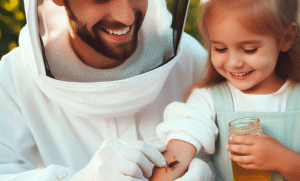
Contents
- 1 First Aid and Immediate Response
- 2 Home Remedies for Bee Stings
- 3 Seeking Medical Attention
- 4 Prevention and Safety Tips
- 5 How to treat a bee sting on a child?
- 6 What should be done if a child gets a bee sting on their arm?
- 7 What is the correct first aid treatment for a bee sting?
- 8 What is the proper management of a bee sting?
First Aid and Immediate Response
Immediate Steps to Take After a Child is Stung by a Bee
Dealing with a bee sting promptly and effectively can minimize discomfort and prevent complications. Here’s a comprehensive guide on the immediate steps to take after a child is stung by a bee.
Step 1: Remove the Stinger
Promptly removing the stinger is crucial because the longer it stays embedded in the skin, the more venom it can release. Follow these steps to remove the stinger effectively:
- Locate the stinger: Look closely at the sting site to identify if the stinger is still lodged in the skin.
- Scrape it off: Use a fingernail, credit card, or a dull knife to gently scrape the stinger out. Avoid using tweezers or squeezing the stinger, as this can inject more venom into the skin.
- Ensure it’s removed: Make sure no part of the stinger remains. Only bees leave their stingers behind, so don’t panic if you don’t find one.
Step 2: Clean the Area
Wash the area thoroughly to reduce the risk of infection:
- Use soap and water: Clean the sting site with mild soap and cool water.
- Pat dry: Gently pat the area dry with a clean towel.
This step is critical in preventing bacteria from entering the sting site.
Step 3: Apply Ice
Applying ice helps minimize pain and swelling:
- Wrap the ice: Place ice or a cold pack in a towel or cloth. Do not apply ice directly to the skin.
- Apply to the sting site: Hold the ice pack on the sting site for about 10-15 minutes. This can reduce inflammation and numb the area.
Repeat the process as needed, but ensure to give breaks between applications to prevent frostbite.
Step 4: Soothe the Itching and Pain
To ease itching and discomfort, consider the following:
- Calamine lotion or hydrocortisone cream: Apply a thin layer to the sting site to reduce itching and irritation.
- Pain relief: If the child is in significant pain, over-the-counter pain relievers suitable for children, such as ibuprofen or acetaminophen, can be administered.
Step 5: Monitor for Allergic Reactions
Keep an eye on your child for any signs of severe allergic reactions:
- Watch for symptoms: Be alert for hives, difficulty breathing, or swelling of the face, lips, or throat.
- Seek help if needed: If severe symptoms appear, call emergency services immediately.
Additional Tips
- Discourage scratching: Remind your child not to scratch the sting site to avoid infection.
- Consult a pediatrician: If swelling persists, talk to your pediatrician about giving your child an antihistamine.
By following these immediate steps to take after a child is stung by a bee, you can effectively manage the situation, minimize pain and swelling, and reduce the risk of complications. Quick, calm action and the right treatment can make a significant difference in your child’s comfort and recovery.
Importance of Removing the Stinger Correctly
The aftermath of a bee sting can be distressing for both child and parent. One of the most important steps in managing a bee sting is the immediate and proper removal of the stinger. Doing this correctly can significantly reduce pain and prevent further complications. Here’s why and how to effectively remove a bee stinger from a child’s skin.
Why Removing the Stinger Correctly Matters
Bee stings are unique because bees leave their stingers embedded in the skin:
- Continuing venom release: The longer the stinger remains in the skin, the more venom is released, intensifying pain and swelling.
- Reducing toxicity: Quickly removing the stinger limits the amount of venom that enters the child’s body, thereby reducing the toxic impact.
- Prevention of further irritation: Proper removal can help prevent additional irritation and potential infections.
Proper Steps for Stinger Removal
Following these steps ensures that the stinger is removed effectively and safely:
- Locate the stinger:
- Identify its presence: Look closely at the sting site to see if the stinger is still embedded in the skin. Only bees leave their stingers behind.
- Use a Flat Object:
- Optimal tools: The best way to remove the stinger is by using something with a flat edge, like a credit card, the back of a knife, or a fingernail.
- Method:
- Gently scrape: Place the flat object slightly below the stinger and gently scrape upwards. The aim is to lift the stinger out without squeezing it, as squeezing can inject more venom.
- Avoid certain actions:
- Do not use tweezers: While it might be tempting to use tweezers or your fingers to pinch and pull out the stinger, this can cause more venom to be injected.
- Refrain from excessive force: Avoid using excessive force which might break the stinger and leave parts of it in the skin.
Post-Removal Care
Once the stinger is correctly removed, follow these steps to ensure proper care:
- Clean the Area:
- Wash with soap and water: This prevents any possible infection and removes contaminants that might have entered the skin.
- Pat dry: Use a clean towel to gently pat the area dry.
- Apply Ice:
- Minimize pain and swelling: Use an ice pack wrapped in a towel and apply it to the sting site for 10-15 minutes.
- Soothe Itching:
- Calamine lotion or hydrocortisone cream: Apply these to help reduce itching and irritation.
The importance of removing the stinger correctly cannot be overstated. It is an essential first aid step that helps minimize venom exposure, reduce pain and swelling, and prevent complications. By using a flat object for removal and following up with proper cleaning and care, parents can effectively manage a bee sting and ensure their child’s quick recovery. It pays to act swiftly and calmly, making those backyard play sessions safer for everyone.

Home Remedies for Bee Stings
Safe and Effective Home Remedies for Treating Bee Stings in Children
Bee stings can be a painful and distressing experience for children, but many safe and effective home remedies can provide relief and promote healing. Parents and caregivers can utilize these simple solutions to manage bee stings without needing to rush to a medical facility for minor cases.
Immediate Actions
Prompt Response: – Remove the Stinger: As soon as a child is stung, promptly remove the stinger using a flat object such as a credit card or the back of a knife to scrape it off. Avoid using tweezers, which can squeeze more venom into the skin. – Clean the Area: Wash the sting site thoroughly with soap and cool water to prevent infection and remove any residual venom.
Initial Relief: – Apply Ice: Use an ice pack wrapped in a cloth and apply it to the affected area for 10-15 minutes to minimize pain and swelling. Repeat the process as necessary, ensuring breaks between applications to avoid frostbite.
Topical Treatments
Soothe the Itching and Inflammation: – Calamine Lotion: Apply a thin layer of calamine lotion to the sting site to reduce itching and irritation. – Hydrocortisone Cream: A small amount of hydrocortisone cream can also help ease itching and inflammation.
Natural Remedies: – Baking Soda Paste: Make a paste with baking soda and a small amount of water. Apply it to the sting site and let it sit for 15-20 minutes before rinsing off. Baking soda can help neutralize the bee venom and reduce swelling. – Honey: Known for its anti-inflammatory and antibacterial properties, a dab of honey on the sting site can provide soothing relief and help prevent infection. – Aloe Vera Gel: Aloe vera has cooling and anti-inflammatory properties. Apply fresh aloe vera gel from a plant or store-bought gel to the sting site to reduce discomfort.
Antihistamines and Pain Relievers: – Antihistamines: Over-the-counter antihistamines, such as diphenhydramine (Benadryl), can be used to reduce itching and swelling. Always consult a pediatrician before administering medication. – Pain Relievers: Children’s pain relievers, such as ibuprofen or acetaminophen, can help alleviate pain and reduce inflammation. Ensure the dosage is appropriate for the child’s age and weight.
Monitoring and Additional Care
Continued Observation: – Monitor Symptoms: Keep a close eye on the child for any signs of severe allergic reactions, such as hives, difficulty breathing, or swelling beyond the sting site. If severe symptoms appear, seek emergency medical attention immediately. – Prevent Scratching: Encourage the child not to scratch the sting site to avoid introducing bacteria and causing an infection.
Follow-Up Care: – Ongoing Care: Continue to apply soothing lotions and monitor the area for any signs of infection, such as increased redness, warmth, or pus. Clean the area daily to promote healing
By employing these safe and effective home remedies for treating bee stings in children, parents and caregivers can provide significant relief and ensure a swift recovery. Quick action, combined with the right treatments, can make a substantial difference in managing the discomfort and potential complications associated with bee stings. Always remain vigilant for signs of severe reactions and consult healthcare professionals when necessary to ensure the best care for your child.
Natural Solutions to Reduce Pain and Inflammation
Managing the pain and inflammation from a bee sting can be effectively done using natural remedies. These solutions are not only easily accessible but also gentle on the skin, making them suitable for children. Here, we outline some of the best natural remedies to reduce discomfort from bee stings.
Honey
Description: – Honey is renowned for its anti-inflammatory and antibacterial properties.
Application: – Dab a small amount: Apply a thin layer of honey directly onto the sting site. – Cover and let it sit: Place a bandage over the honey and allow it to sit for about 30 minutes to an hour.
Benefits: – Honey helps reduce swelling and prevents infection, soothing the affected area.
Baking Soda
Description: – Baking soda is an alkaline substance that can help neutralize bee venom, thereby reducing pain and swelling.
Application: – Create a paste: Mix baking soda with a small amount of water to create a thick paste. – Apply to the sting site: Spread the paste over the sting and let it sit for 15-20 minutes. – Rinse off: Wash the area with cool water and pat dry.
Benefits: – Baking soda can provide immediate relief from pain and decrease inflammation.
Apple Cider Vinegar
Description: – Apple cider vinegar has acidic properties that can help neutralize the alkaline venom of the bee sting.
Application: – Soak a cotton ball: Dip a cotton ball in apple cider vinegar. – Apply to the sting site: Place the cotton ball on the sting and hold it there for several minutes. – Repeat as needed: Reapply as necessary to maintain relief.
Benefits: – Apple cider vinegar reduces swelling and alleviates pain, promoting quicker healing.
Aloe Vera
Description: – Aloe vera is known for its soothing and anti-inflammatory properties or wound healing.
Application: – Use fresh gel: Break open an aloe vera leaf and extract the gel. – Apply directly: Rub the fresh gel onto the sting site. – Reapply as needed: Use the gel several times a day for continuous relief.
Benefits: – Aloe vera soothes the skin, reduces inflammation, and speeds up the healing process.
Essential Oils
Description: – Certain essential oils, such as lavender or tea tree oil, have anti-inflammatory and antiseptic qualities.
Application: – Dilute the oil: Mix a few drops of the essential oil with a carrier oil like coconut or olive oil. – Apply to the sting site: Gently rub the mixture onto the sting. – Repeat as needed: Apply 2-3 times daily for best results.
Benefits: – Essential oils not only reduce pain and swelling but also help prevent infection.
Ice Packs
Description: – While not a natural remedy in the traditional sense, ice is a natural way to reduce swelling and numb pain.
Application: – Wrap ice in a cloth: Never apply ice directly to the skin. – Apply to the sting site: Hold the ice pack on the affected area for about 10-15 minutes. – Repeat: Allow breaks between applications to prevent frostbite.
Benefits: – Ice can significantly reduce swelling and alleviate pain quickly.
Utilizing these natural solutions to reduce pain and inflammation can make a significant difference in managing the discomfort associated with bee stings. These remedies are not only effective but also safe for children, providing quick relief and promoting faster healing. By keeping these natural options on hand, parents can ensure they are well-prepared to handle unexpected bee stings efficiently and soothingly.

Seeking Medical Attention
When to Seek Medical Help for Bee Stings in Children
Bee stings can be a common occurrence for children, especially when playing outdoors. While most bee stings cause only mild discomfort, there are cases where medical intervention is necessary. Understanding when to seek medical help can be critical in ensuring your child’s safety and well-being.
Immediate Allergic Reactions
Signs and Symptoms of Anaphylaxis: – Difficulty breathing: This could indicate swelling in the airway and is a severe symptom. – Swelling of the face, lips, or throat: Significant swelling in these areas can impede breathing. – Rapid pulse: An unusually fast heartbeat may accompany allergic reactions. – Hives and widespread redness: These symptoms can appear away from the sting site. – Dizziness or fainting: Feeling light-headed or losing consciousness is a grave sign. – Nausea, vomiting, or diarrhea: Gastrointestinal symptoms shortly after the sting.
Action Steps: 1. Seek emergency help: Call emergency services immediately if any of the symptoms above are present. 2. Administer epinephrine: If your child has a known bee sting allergy and has been prescribed an epinephrine auto-injector, use it immediately as directed.
Delayed Reactions
Extended Symptoms: – Severe redness and swelling: If the swelling and redness extend significantly beyond the sting site, it’s a sign to consult a healthcare provider. – Persistent pain and swelling: Pain and swelling that do not subside after a few days may need medical evaluation.
Action Steps: 1. Consult your pediatrician: Reach out to your child’s healthcare provider to discuss the symptoms and receive guidance. 2. Possible referral to an allergist: If your child experiences a severe reaction, you may need a referral to an allergy specialist to evaluate for potential venom allergies and formulate a prevention plan.
Risk Factors for Severe Reactions
Pre-existing Allergies and Conditions: – Asthma: Children with asthma may have more severe reactions. – Other allergies: Children allergic to pollen, dust, or other common allergens may be at increased risk. – Family history of allergies: A family history of severe allergic reactions can heighten risk.
Action Steps: 1. Discuss with a healthcare provider: If your child has any of these risk factors, consider discussing preventive measures and potential treatments with your doctor.
Infection and Other Complications
Signs of Infection: – Increased redness and warmth: The area around the sting site becomes more inflamed and warm over time. – Pus: The presence of pus around the sting site can indicate an infection. – Fever: A fever following a bee sting suggests a possible infection.
Action Steps: 1. Clean the area: Ensure the sting site is clean and watch for signs of infection. 2. Contact your pediatrician: Seek medical advice if infection is suspected.
Knowing when to seek medical help for bee stings in children is crucial. Immediate allergic reactions necessitate emergency attention, while extended or severe symptoms warrant a visit to your child’s pediatrician. Keeping a close eye on your child’s condition and being prepared to act can make all the difference in effectively managing bee stings. Always err on the side of caution, especially if risk factors or severe symptoms are present, ensuring your child’s health and safety.
Potential Complications and Allergic Reactions to Bee Venom
Bee stings can lead to various complications, some of which can be severe, especially in children. Understanding the potential risks and allergic reactions associated with bee venom can help parents and caregivers take appropriate measures to ensure the safety and health of their children.
Local Reactions
Typical Symptoms: – Redness and swelling: These are the most common reactions at the sting site. – Pain and itching: Children often experience localized pain and itching.
Management: – Cold Compress: Applying a cold compress can reduce swelling and offer pain relief. – Analgesics: Over-the-counter pain relievers such as aspirin or acetaminophen can help alleviate pain.
Note: While these reactions are usually mild, multiple stings can be more dangerous in children due to their smaller body size and lower tolerance to venom.
Infections
Risk Factors: – Break in the skin: Any disruption, including a bee sting, can usher in bacteria, leading to an infection. – Scratching: Children often scratch the sting site, exacerbating the risk of infection.
Signs of Infection: – Increased redness and warmth: The area around the sting becomes more inflamed. – Pus: Presence of pus indicates an infection. – Fever: A fever is a sign of potential systemic infection.
Prevention and Treatment: – Keep the area clean: Wash the sting site with soap and water. – Discourage scratching: Encourage your child not to scratch to prevent bacterial introduction. – Consult a doctor: If signs of infection appear, seek medical advice for appropriate treatment.
Allergic Reactions
Types of Allergic Reactions: – Mild allergic reactions: Rash, itching, and localized hives can be indicators. – Moderate to severe reactions: Symptoms extend beyond the sting site, including facial swelling, difficulty breathing, and hives over large body areas.
Severe Allergic Reactions (Anaphylaxis): – Symptom onset: Symptoms of anaphylaxis, such as throat swelling, difficulty breathing, rapid pulse, and dizziness, can appear quickly. – Immediate action required: Administer an epinephrine auto-injector if available and call emergency services immediately.
Risk Factors: – Pre-existing allergies: Children with other allergies (e.g., pollen, dust) or asthma are at higher risk. – Family history: Allergies are generally hereditary, so a child with an allergic parent should be closely monitored.
Preventive Measures: – Allergy Testing: Consult an allergist for testing, especially if the child has a family history of allergies. – Venom Immunotherapy: This treatment can reduce the risk of severe reactions from 60% to about 5%.
Multiple Stings
Higher Risk in Children: – Greater vulnerability: Children are more at risk from multiple stings because their bodies can’t handle as much bee venom. – Serious complications: Large amounts of venom can lead to severe systemic reactions.
What to Do: – Seek immediate medical attention: Promptly consult healthcare providers for guidance and management.
Understanding the potential complications and allergic reactions to bee venom is crucial for parents and caregivers. From local reactions and infections to severe allergic responses like anaphylaxis, knowing what to look for and how to respond can make all the difference. Preventive measures and quick, effective treatment are key to managing bee stings and ensuring the well-being of children. Always consult healthcare professionals for advice tailored to your child’s specific needs, and stay vigilant for signs of complications.
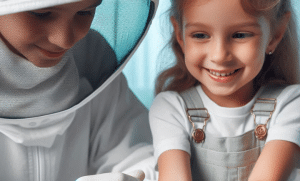
Prevention and Safety Tips
Practical Tips to Prevent Bee Stings in Children
Bee stings are common during outdoor activities, but with some practical tips, you can significantly reduce the risk of your child getting stung. Here’s how you can minimize bee encounters and keep your child safe.
Dress Appropriately
Clothing Choices: – Avoid Bright Colors and Floral Patterns: Bees are attracted to bright colors and patterns that resemble flowers. – Opt for Light-Colored Clothing: Lighter shades are less enticing to bees. – Cover Up: Long sleeves and pants provide a barrier between your child’s skin and potential stings.
Headgear: – Wide-Brimmed Hats: These can provide extra protection for the face and neck. – Avoid Open-Toed Shoes: Ensure that your child wears closed shoes to protect their feet.
Manage Scents
Fragrances: – Skip Floral Fragrances: Avoid using perfumes, scented lotions, and shampoos with floral scents as these can attract bees. – Use Unscented Personal Care Products: Opt for unscented or lightly scented products.
Food and Drinks: – Keep Food Covered: Food and sweet drinks can attract bees, so ensure they are covered when not in use. – Clean Up Promptly: After eating, clean up food residues and spills immediately.
Be Mindful of Bee Habitats
Avoid Bee Hotspots: – Stay Clear of Flowering Plants: Bees are often found around flowers. Teach your child to admire blooms from a distance. – Avoid Dark, Hollow Spaces: Bees can build their nests in trees, shrubs, and underground burrows. Be mindful of such areas.
Exercise Caution with Bees: – Move Slowly: If a bee approaches, teach your child to stay calm and move away slowly. – Don’t Swat Bees: Swatting can provoke bees. Encourage your child to avoid sudden movements around them.
Educate and Prepare
Teach Bee Awareness: – Recognize Bees: Help your child identify bees and understand their importance to the ecosystem. – Respect Their Space: Teach your child the importance of not disturbing bees or their nests.
Have a Bee Sting Plan: – Stinger Removal Tools: Carry a credit card or similar flat object for promptly removing stingers. – First Aid Kit: Include antihistamines, hydrocortisone cream, and antiseptic wipes in your first aid kit.
Outdoor Activities
Picnic Precautions: – Select Safe Locations: Choose picnic spots away from flowering plants and standing water. – Use Bee-Repellent Decor: Set up items that can deter bees, like citronella candles (keeping in mind children’s safety with candles).
Garden Safety: – Garden Maintenance: Regularly maintain your garden to minimize bee-attracting flowers in play areas. – Water Sources: Bees are drawn to water. Ensure your child avoids areas with standing water.
By following these practical tips to prevent bee stings in children, you can significantly reduce the risk and make outdoor activities safer and more enjoyable. From choosing the right clothing to teaching bee awareness, every precaution can help protect your child from the pain and potential complications of bee stings. Always remain vigilant and prepared with a plan in place for any unexpected encounters with bees.
Safety Measures When Outdoors to Avoid Bee Encounters
Spending time outdoors is one of the great joys of childhood, but the risk of bee stings can put a damper on the fun. Thankfully, there are numerous safety measures you can take to minimize the likelihood of encountering bees. Here’s how to prepare and protect your children during outdoor activities.
Appropriate Clothing
Dress for Protection: – Wear Light-Colored Clothing: Bees are less attracted to light colors, making it a safer choice. – Avoid Bright Colors and Floral Patterns: These can be mistaken for flowers and attract bees. – Long Sleeves and Pants: Covering more skin reduces the chances of bee stings.
Shoes and Hats: – Closed-Toe Shoes: Protect your child’s feet from bees that may be on the ground. – Wide-Brimmed Hats: Offer additional protection for the face and neck area.
Fragrance Management
Scent Awareness: – Avoid Floral Scents: Perfumes, lotions, and shampoos with floral scents can attract bees. – Use Unscented Products: Opt for unscented personal care items to minimize attracting bees.
Food and Drink Precautions: – Cover Food and Drinks: Ensure food and beverages are covered when not being consumed, as they can attract bees. – Clean Up Quickly: Promptly clean any spills and food residues that might attract bees.
Habitat Awareness
Bee Hotspot Avoidance: – Stay Away from Flowering Plants: Bees frequent flowering plants, so maintain a safe distance. – Avoid Bee Nests: Educate your child on recognizing bee nests and keeping away from them.
Behavior Around Bees: – Move Slowly: Teach your child to remain calm and move slowly away if a bee approaches. – Don’t Swat Bees: Swatting at bees can provoke them. Encourage your child to stay calm and still.
Timing Your Activities
Best Times for Outdoor Play: – Avoid Peak Bee Activity Hours: Bees are most active during the day, especially mid-morning to mid-afternoon. Plan outdoor activities for early morning or late afternoon.
Equip Yourself
Essential First Aid Kit: – Bee Sting Tools: Include items like a credit card for stinger removal and antiseptic wipes. – Medications: Pack antihistamines and hydrocortisone cream for immediate relief if a sting occurs.
Educate and Prepare: – Bee Awareness: Teach your child how to identify bees and the importance of not disturbing them. – Emergency Plan: Have a plan in place for treating bee stings, including knowing how to use an epinephrine auto-injector if necessary.
Maintaining Your Outdoor Space
Garden Care: – Regular Maintenance: Keep your garden well-maintained to limit the number of flowering plants near play areas. – Remove Standing Water: Bees are drawn to water; ensure there are no standing water spots in your yard.
Picnic Precautions: – Select Safe Areas: Choose picnic spots away from flowers and tall grasses. – Use Bee Deterrents: Consider using bee-deterring items like citronella candles during outdoor gatherings (keeping child safety in mind).
By following these safety measures when outdoors to avoid bee encounters, you can help ensure your child’s outdoor adventures are enjoyable and sting-free. From clothing choices and scent management to educating your child on bee behavior, taking these steps can significantly reduce the risk of bee stings. Preparedness and prevention go a long way in keeping your family safe and making every outdoor experience a pleasant one.
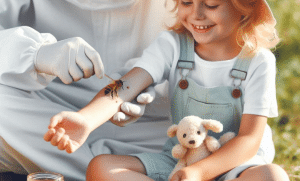
Summary of Best Practices for Bee Sting Treatment in Children
Bee stings can cause discomfort and, in some cases, serious allergic reactions in children. Effective treatment and preventive measures can help manage symptoms and reduce the risk of complications. Here’s a concise summary of best practices for handling bee stings and ensuring a speedy recovery for your child.
Immediate Response
Stay Calm and Reassure: – Remain Composed: Your calm demeanor will help soothe your child. – Comfort Your Child: Reassure them that you know what to do and they will be fine.
Remove the Stinger: – Use a Flat Object: Promptly scrape the stinger out using a credit card or similar flat object. Avoid using tweezers to prevent injecting more venom.
Cleaning and Initial Treatment
Clean the Area: – Soap and Water: Thoroughly wash the sting site with soap and cool water to prevent infection. – Pat Dry: Gently pat the area dry with a clean towel.
Apply a Cold Compress: – Cold Pack or Ice: Use a cold pack or ice wrapped in a cloth and apply to the sting site for 10-15 minutes to reduce pain and swelling.
Over-the-Counter Medications
Topical Treatments: – Hydrocortisone Cream: Apply to reduce redness, itching, swelling, and pain. – Calamine Lotion: Helps soothe itching and irritation.
Oral Medications: – Antihistamines: Administer oral antihistamines like diphenhydramine (Benadryl) to alleviate itching and hives. – Pain Relievers: Use child-appropriate pain relievers such as ibuprofen or acetaminophen to manage pain and inflammation.
Monitoring and Medical Attention
Watch for Allergic Reactions: – Mild Reactions: Monitor for extended redness and swelling; consult a healthcare provider if these symptoms persist. – Severe Reactions: In case of symptoms like difficulty breathing, facial swelling, or hives, seek emergency medical help immediately.
Post-Treatment Care: – Observe the Site: Monitor the sting site for signs of infection, such as increased redness, warmth, or pus. – Prevent Scratching: Encourage your child not to scratch the area to avoid further irritation or infection.
Preventive Measures
Outdoor Safety: – Dress Appropriately: Ensure your child wears long sleeves and pants when playing outside. – Avoid Fragrances: Use unscented personal care products to avoid attracting bees.
Educate and Prepare: – Teach Bee Awareness: Instruct your child to remain calm and walk away if a bee approaches. – Bee Sting Kit: Keep a bee sting kit handy, especially if your child has known allergies. This kit should include essentials like antihistamines, hydrocortisone cream, and an epinephrine auto-injector if prescribed.
Being prepared and knowledgeable about the best practices for bee sting treatment in children can make a significant difference in managing the situation effectively. From immediate responses and appropriate medical care to preventive measures, these practices ensure your child remains safe and comfortable. Always consult healthcare providers for personalized medical advice and keep essential first aid supplies ready for quick access. A proactive approach will help you protect your child and give you peace of mind during outdoor activities.
FAQs About Bee Stings in Pediatric Cases
When it comes to children and bee stings, parents naturally have a lot of questions. Understanding how to handle these incidents can make a significant difference in the comfort and safety of your child. Here, we address some of the most frequently asked questions about bee stings in pediatric cases.
What Should I Do Immediately After My Child Is Stung by a Bee?
Immediate Steps: 1. Stay Calm and Reassure: Your calmness will help soothe your child. 2. Remove the Stinger: Promptly remove the stinger using a flat object like a credit card. Avoid using tweezers to prevent injecting more venom. 3. Clean the Area: Wash the sting site with soap and cool water to reduce the risk of infection. 4. Apply Ice: Use an ice pack wrapped in a cloth and apply it to the sting site for 10-15 minutes. This will help minimize pain and swelling.
How Can I Reduce Itching and Swelling?
Topical Treatments: – Calamine Lotion: Apply to the sting site to ease itching. – Hydrocortisone Cream: Helps reduce redness, itching, swelling, and pain. – Oral Antihistamines: Over-the-counter options like diphenhydramine (Benadryl) can help decrease itching and hives.
Are My Child’s Symptoms Normal or a Sign of an Allergic Reaction?
Normal Symptoms: – Pain and Swelling: Immediate pain, redness, and swelling at the sting site. – Itching: Itching around the sting area.
Allergic Reaction Symptoms: – Severe Swelling: Swelling that extends beyond the sting site. – Hives: Widespread hives or welts. – Difficulty Breathing: Trouble breathing, wheezing, or swelling of the face, lips, or throat. – Rapid Pulse: An unusually fast heartbeat. – Dizziness or Fainting: Feeling lightheaded or fainting.
If any severe symptoms appear, seek emergency medical help immediately.
Can Bee Stings Lead to Infections?
Risk of Infection: Yes, bee stings can lead to infections if the area is not cleaned properly or if the child scratches the sting site.
Signs of Infection: – Increased Redness and Warmth: The area around the sting becomes more inflamed and warm. – Pus: Presence of pus around the sting site. – Fever: A fever following a bee sting suggests a possible infection.
Prevention: – Clean the Area: Wash with soap and water immediately. – Prevent Scratching: Encourage your child not to scratch the sting area.
How Can I Prevent Bee Stings?
Preventive Measures: – Dress Appropriately: Use long sleeves, long pants, and light-colored clothing. – Avoid Fragrances: Skip floral scents in personal care products. – Teach Calm Behavior: Educate your child to remain calm and walk away if a bee is near. – Monitor Food and Drinks: Keep food and drinks covered outdoors to avoid attracting bees.
When Should I Seek Medical Attention?
Medical Attention Needed: – Severe Allergic Reaction: Difficulty breathing, swelling of the face or throat, rapid pulse, or dizziness. – Persistent Symptoms: If swelling and pain do not subside after a few days or if signs of infection appear. – Previous Severe Reactions: If the child has a history of severe allergic reactions to bee stings.
Dealing with bee stings can be straightforward if you know what steps to take and what to watch for. By understanding these FAQs about bee stings in pediatric cases, you can be better prepared to handle such incidents, ensuring the safety and comfort of your child. Always keep an eye out for signs of severe reactions and consult with healthcare providers when necessary.
How to treat a bee sting on a child?
If a child is stung by a bee, it is important to act quickly to reduce pain and swelling. The first step is to remove the stinger if it is still in the skin, using a scraping motion with a fingernail or a credit card. Wash the area with soap and water to prevent infection.
To reduce swelling and pain, apply a cold compress or ice pack to the sting site. You can also give the child acetaminophen or ibuprofen to help alleviate discomfort. It may also be helpful to apply a paste of baking soda and water or a hydrocortisone cream to the area.
Monitor the child for signs of an allergic reaction, such as difficulty breathing, swelling of the face or throat, or a rash. If any of these symptoms occur, seek medical attention immediately.
It is important to teach children to be cautious around bees and other insects to prevent future stings. Encourage them to stay calm and avoid swatting at bees, as this can provoke them to sting.
What should be done if a child gets a bee sting on their arm?
If a child gets a bee sting on their arm, the first thing to do is to remove the stinger as soon as possible. This can be done by scraping it off with a fingernail or a stiff object like a credit card. After removing the stinger, wash the area with soap and water to prevent infection.
To reduce pain and swelling, apply a cold compress or ice pack to the affected area. You can also give your child an oral antihistamine to relieve itching and discomfort.
If the child experiences severe allergic reactions such as difficulty breathing, swelling of the face or throat, or dizziness, seek immediate medical attention. It’s important to monitor the child for any signs of a severe allergic reaction, as this can be life-threatening.
What is the correct first aid treatment for a bee sting?
The correct first aid treatment for a bee sting involves removing the stinger if it is still lodged in the skin. Use a clean, straight edge, like a credit card, to scrape the stinger out in a sideways motion. Wash the affected area with soap and water, and apply a cold compress to reduce swelling and pain.
You can also take an over-the-counter antihistamine or use a hydrocortisone cream to help with itching and inflammation. If the person stung has a severe allergic reaction, such as difficulty breathing or swelling in the face or throat, seek immediate medical attention.
What is the proper management of a bee sting?
The proper management of a bee sting includes removing the stinger as quickly as possible by scraping it out with a blunt object, washing the area with soap and water, applying a cold compress to reduce swelling, taking an antihistamine or using a corticosteroid cream to relieve itching and inflammation, and keeping the affected area elevated to reduce pain and swelling.
If the person stung experiences severe reactions such as difficulty breathing, swelling of the face or throat, or a rapid heartbeat, seek immediate medical attention as it may indicate a serious allergic reaction called anaphylaxis.
That concludes our guide on the best practices for treating bee stings in children. Remember, the key to effective treatment is staying calm and following the steps precisely to ensure your child’s comfort and safety. If your child experiences severe symptoms, don’t hesitate to call 911 immediately.
We hope you found this information helpful and empowering. We’d love to hear from you—share your experiences and any additional tips you have for treating Bee Sting Treatment in kids. Stay safe and thank you for choosing bees partners for your family’s health needs!
Important Notice on Content Rights
All rights reserved to Bees Partners © 2025. Copying, republishing, translating, or quoting more than 10% of this content is prohibited without prior written permission. For commercial or academic use, please contact: info@beespartners.dk.
Note: Limited quotation is allowed with clear source attribution and a direct link to the original article.


